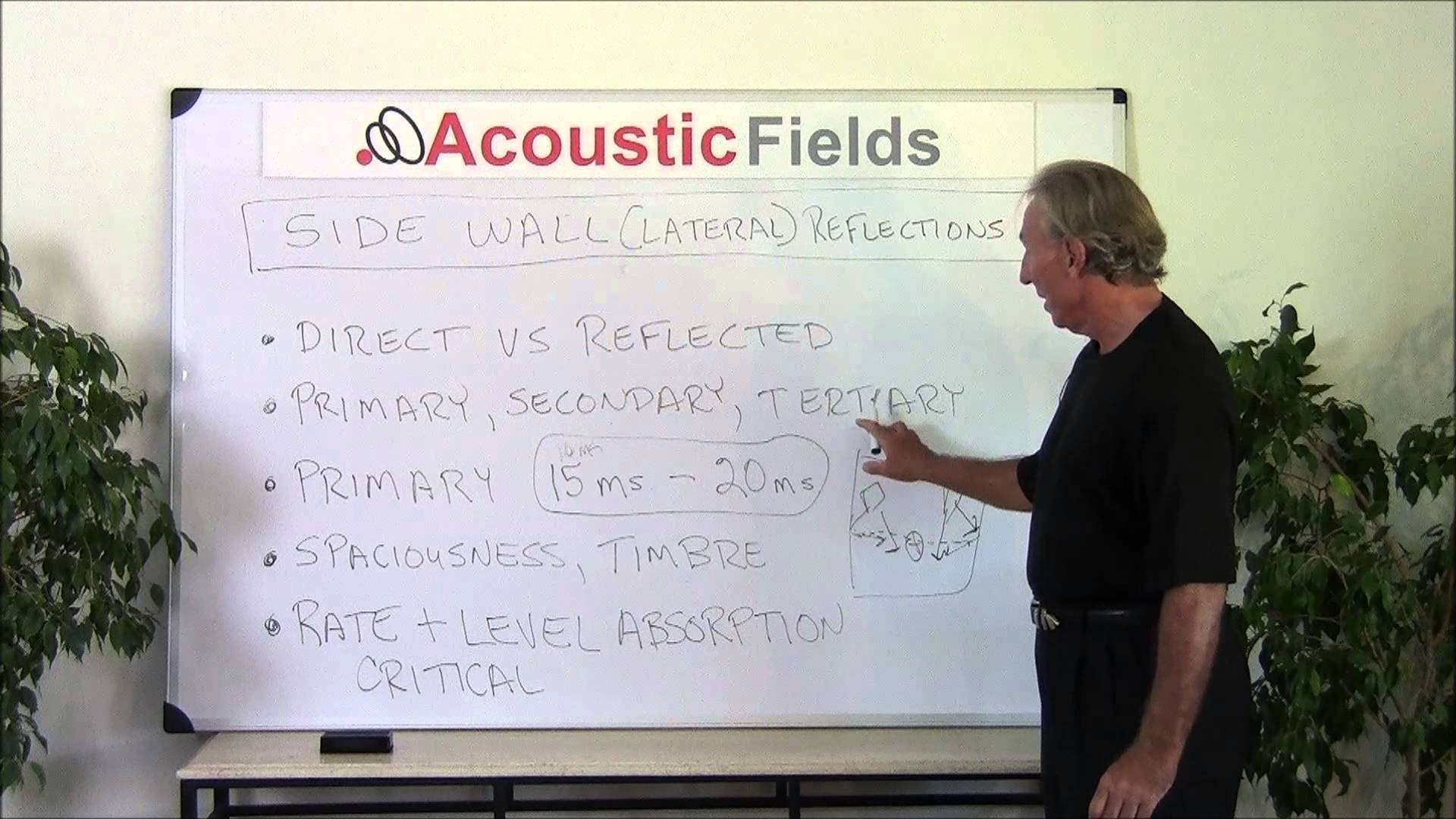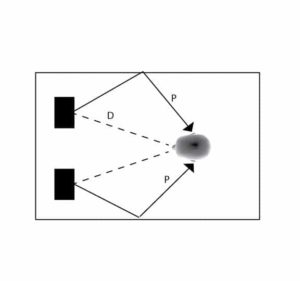Control Room Reflections & Direct Sound
The purest and cleanest of all energy from our loudspeakers is the direct energy. The direct energy is the energy that travels in a direct (straight) line from the speaker to the listener. We know the shortest distance between two points is a straight line and the direct energy from our loudspeakers is the straightest and shortest line of energy we will get. Control room reflections confuse the wanted, direct energy from our loud speakers.
Purest Sound
In our direct sound is all the energy of the recording. It is all the information that the engineer has decided to put into each track. It is the lead guitar, the drums, and all other instruments and vocals. If the sound of the room in which the instrument or vocal was recorded in was to be in the recording, one will find it in the direct sound. Direct sound is similar to headphone sound. We can hear everything in the recording, but we do not want to hear any sonic additions from our control or listening room.
Signal Manipulation
We can move energy around with our electronics. We can process an analog signal and then convert it to digital and send it through countless circuits to add or subtract this or that artifact. There is nothing incorrect about this process because we are controlling the electronic manipulation. However, when our room starts to produce numerous room distortions such as phantom images from all of its activity, we must exert the same control in this analog domain as we do our digital processing.
In this video I explain the concept of side wall reflections in greater detail.
Room Distortions
Unfortunately, we must reproduce this wanted direct energy into a box. The box or room has walls, ceiling, and a floor. When sound energy leaves our speakers it is radiated in many directions. We have the direct energy but we also have energy that radiates from the speakers rear and sides. Energy also radiates from speaker top and bottom. All of this energy moves through our room until it strikes an object or wall. In our playback or monitoring listening positions, we must address all of these reflections but pay particular attention to the three main lateral reflections from our side walls; the primary, secondary, and tertiary reflections.
Primary Reflections
The primary reflection is caused by the energy leaving the loudspeaker and striking the right or left side wall. That energy is then reflected back to the listening position. The reflection intermixes with the direct energy. The juxtaposing of reflected energy upon the direct energy produces a time delayed interval of sound that can be heard as a virtual image of the direct sound if the audibility of the reflection achieves a certain level.The most important factor is that the reflected energy from the side wall is delayed in time when compared to the direct energy.
Secondary Wall Reflections
Once our primary reflection strikes the nearest side wall, it then heads over to the opposite side wall. As the reflection travels across the room, it mixes with the direct sound from our loudspeakers. Since we know have the primary reflection and now the secondary one, we have two forms of time delayed energy that is striking our listening or monitoring position at different time intervals than our wanted direct sound.
Tertiary Reflections
Once this secondary reflection moves across our monitoring position from the second reflection point, it becomes a tertiary reflection when it strikes the side wall where this whole reflection process began. So we started with the closest side wall, across the room to the opposite side wall, and now striking the first side wall again. This back and forth process produces a time delayed, phantom image that is then superimposed upon the wanted direct sound. This is not something that is wanted.
Rear Wall
The rear wall of our control room receives the energy from our loudspeakers and then “throws” it back to us at the monitoring position. This reflected energy from the rear wall is delayed in time from the direct sound by large amount of time. It is enough of a delay and long enough in the time dimension, that it can approach an echo if physical distances are long between the rear wall and the monitoring position. This time delayed signal confuses us at the listening or monitoring position, when we really are trying to seek some type of audio clarity.
Front Wall
The front wall can present similar reflection issues as the back wall, all though, we will never have the distances with the front wall to reach a possible echo. We must be careful with glass surfaces for a front wall as sound takes on the characteristics of the surface that it strikes. Sound energy that strikes glass, takes on that bright, glaring, harsh sound that glass produces. We must pay attention to all room surface materials.
Control Room Reflections – Ceiling Reflections
Ceiling reflections can add to our direct sound confusion, especially in today’s smaller rooms. With lower ceilings, the reflections can arrive even quicker at our monitoring position than the reflections from our side walls. Our floors can have the same impact along with the reflections from our consoles. If we had to rank control room reflections in order of arrival times at the monitoring position, we would have to give the floor and ceiling reflections top billing because of their physical proximity to our listening position.
Reflection Management
Control room reflections from our ceilings, floors, front and rear walls, along with both side walls, add unwanted energy and produce time delayed, phantom images when mixed with the direct, straight line sound from our loudspeakers or monitors. Reflections arrive at our monitoring positions delayed in time and add sonic distortions to our sound presentation. We need to manage all reflections from all room boundary surfaces, either through absorption or diffusion technologies, to minimize the sound of the room. We can start with the side walls as an example.
If you want to learn more about this subject please sign up for our free room acoustic treatment videos and 150+ page ebook which provide step by step instructions. Get instant access by signing up now.
Thanks
Dennis












The discussion on ductwork noise transmission from Acoustic Fields highlights crucial aspects of HVAC system acoustics. The movement of air…
Great build plans. thank you Denis
You must use absorption. Never place a chair against a wall.
A friend and I built several diffusors using these plans and they turned out absolutely beautiful. Very good instructions and…